This simple method of spooling braid will improve performance on your casting tackle and help save money.
It's safe to say that everyone is different and, not surprisingly, fishing does different things for different people.
For me, it's not so much about catching them (lets be real: anyone can reel in a fish) as it is about improving.
You can always get better!
This is why I travel to entirely new bodies of water, especially bass lakes, to come out of my comfort zone and try new stuff not available to fish at home.
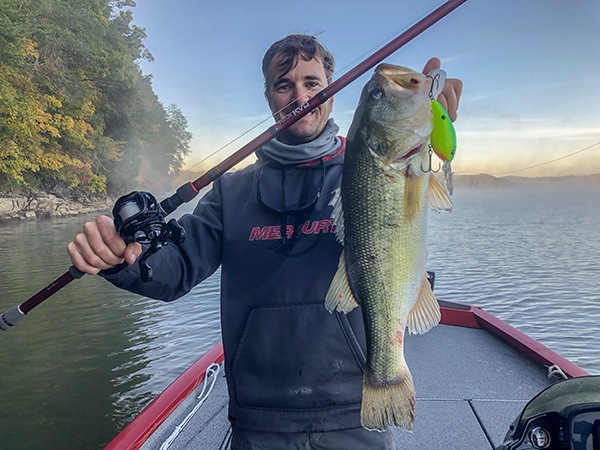
Deep cranking is fun!
That's what happened this past week and, while I had a good time, there were a lot of things learned.
How To Increase Braided Line Casting Performance
This time of year Lake Chickamauga is stuffed with caverning grass mats that offer forage and cover to the lake's resident bucket mouths.

Note traces in the grass.
It's pretty neat, and one of the best ways to catch bass there is by throwing a frog.
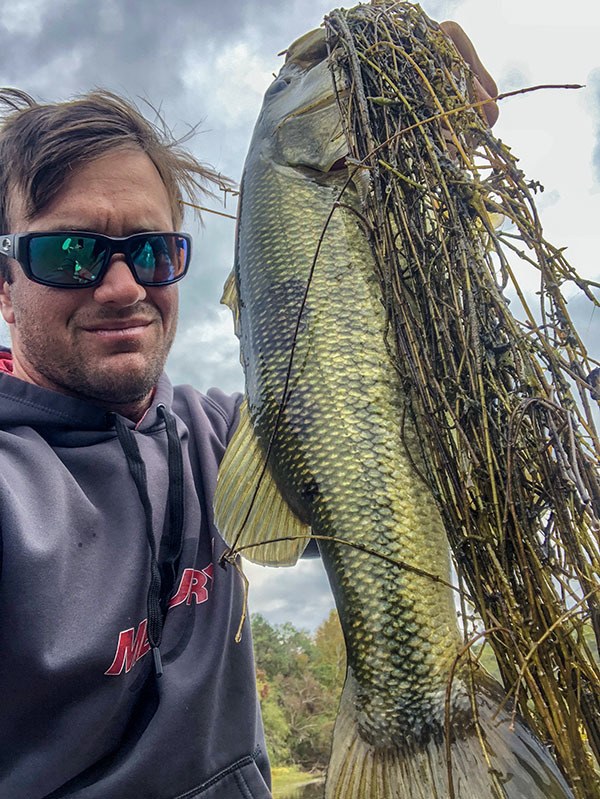
For scenarios like this, it's best to use a 7'6" medium-heavy or heavy, fast action casting rod, paired with a quick baitcaster and, you guessed it: braided line.
Thick braided line.
We're talking at least 50lb or higher.
Why thick line?
Two reasons:
- Hauling fish out of thick cover is a tough job that calls for tougher tackle.
- Thicker braided line is less likely to pull into itself.
Knowing this, my reels were spooled with fresh 65lb line.
Accidental Discovery
When I spool my reels, all of them get a mono backer.
Yes, monofilament backer goes onto all of them, because no one needs 200 yards of braided line when fishing for specks or reds (or, in this case, bass).
This reduces the amount of braid on each reel, so I am able to get a single spool to fill a few reels instead of one.
But, my main froggin' combo got a little more backer than usual, and this greatly improved the reel's casting performance.
In order to explain how, let's address a problem with braid.
The Problem
Braid packs poorly onto spools, mostly because it doesn't stretch.
So instead of being wound tight like mono or fluoro, lengths of it are slightly loose, too slight for an undiscerning eye to detect.
Yes, you can pack it tightly at home, but after a few casts on the water it will become loose again.
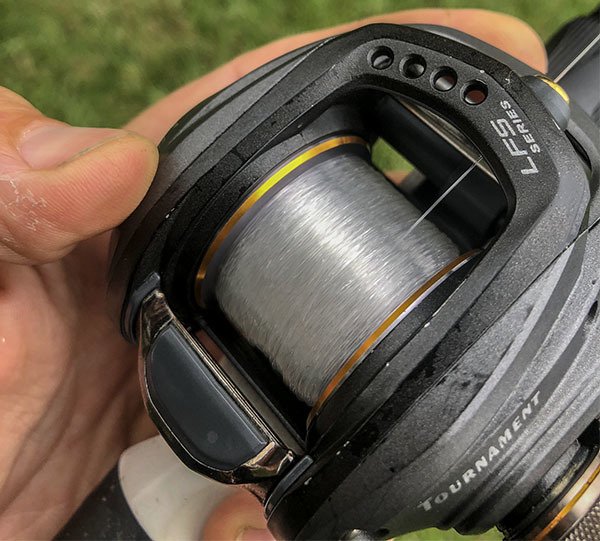
Since they're extruded and round in shape, monofilament and fluorocarbon are easier to pack tightly for increased casting performance.
And, because it's so thin (and rarely round-shaped) it can, and will, pull down between those loose strands.
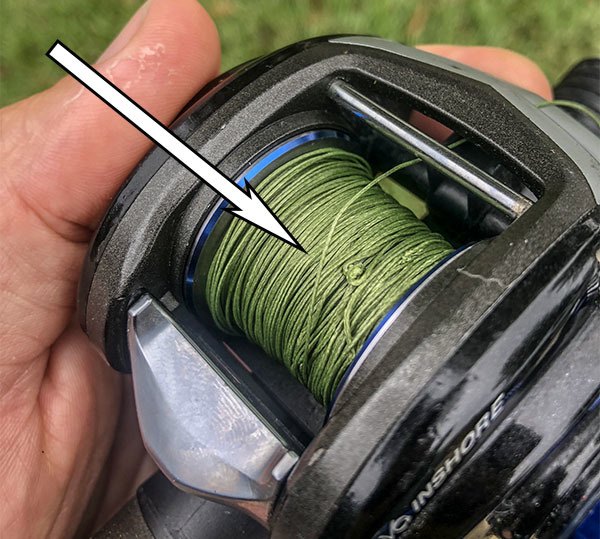
In addition to this, braid doesn't have a uniform surface like mono or fluoro because it is woven and not extruded.
This creates more friction between layers of line, causing braid to catch itself as the spool turns, often resulting in backlash or a cast "failing to start".
The Solution
Halfway through a day of frogging I suddenly noticed that my braid experienced none of the problems mentioned above.
After giving it a little thought, it was apparent the increased performance was due to the extra monofilament backer:
- mono is packed tighter
- braid can't pull through the backer
- braid peels easily off monofilament
Because you are only using as much as you need, the remainder of braid in your cast is coming off of slippery monofilament, not surface-grabbing braid.
Important Details
It's important you measure off the amount of braid you'll need to make a cast.
So if you know you will be casting 30 yards, then spool on 30 yards of braid after filling the rest of the spool with monofilament.
It'd be good to add a few feet, to prevent your knot from flying off the spool, so make that 31 yards.
I know my longest casts were about 50 yards (I measured them), and that was exactly how much braid was spooled onto the reel.
Do this, and you'll be re-packing the braid on your spool each time you finish a retrieve.
Another benefit is reduced cost! You'll be spending less money on braid, because you're only using what you need.
You're welcome. :)
Conclusion
We all know that quality casting equals quality fishing.
So take some time, spool braid onto your baitcasters using this method, and you'll be making longer casts, more often.
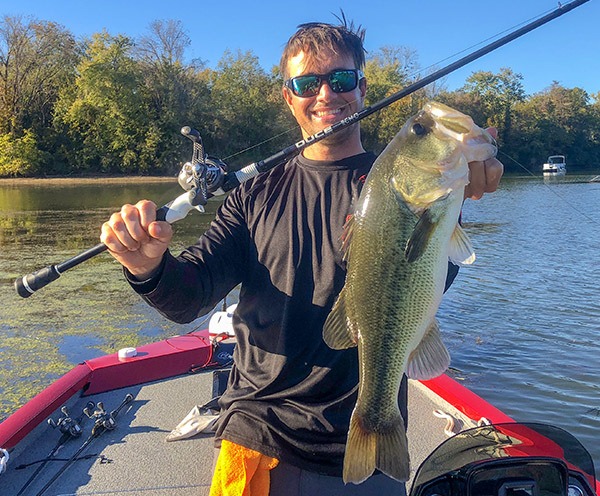
When you do this, the odds are in your favor and you'll catch that hammer you always wanted.
Tight lines, y'all!

It takes a little trial and error, but I found spooling a reel in reverse helps to figure out how much to use.
Ok so how do you figure out how much mono to put on?
Hey Aaron, great question.
The way I see it, every type of rod, reel, and line exists to be combined to serve the various needs of your fishing trips.
A specific combination used for sight fishing bull redfish is much different from that of one used for jigging speckled trout on bridge pilings.
Notice how specific those two examples are.
So, since you’re asking, I don’t use braid to catch trout in the first place.
Normally I use 12-15lb mono or fluoro, so I would never have the issue you described.
It casts smoother, farther and gives an overall better presentation.
Should you hook into a bull red, you then have the option of fighting and landing him (12-15lb mono/fluoro is plenty) or popping the line and getting back to trout fishing.
But let’s say you were using 20lb braid anyways.
The idea isn’t to spool enough braid that you cast down to the knot, you want to leave a few yards precisely for the reason you stated.
With a heavy enough drag and powerful rod you will be able to stop a big redfish and turn him before you get down to your backer.
We do it all the time sight fishing.
But let’s say he didn’t stop, and started to peel out drag.
Then you’re into your backer and have to make the necessary adjustments to your drag and fighting style to get back into your braid and land the fish.
If you tied your knots right you won’t have anything to worry about.
However, avoid fudging rod/reel/line combos in the first place and you won’t have this problem.
Thanks for commenting, Aaron.
This is a good idea, but what if you occasionally hook into a bull red. This happened on a trip last year. I was catching 2 lb trout then a whale would hit my line. I had very little mono backer with my 20 lb braid of at least 100 yards. When these monsters got on I would have enough time to loosen the drag before the line had buried itself into the loosely wound braid and it would be come stuck resulting in usually my leader breaking off. This happened several times. Should I have just left my drag very loose from the start. I don’t like a hook set and my drag pulls out. It just doesn’t make me confident I have set the hook properly. Any ideas how I should handle this situation.
Excellent! Thanks for sharing!
Amazon and eBay sell a braid brand named reaction tackle- 19$ for 500 yards. Every bit as good as the expensive lines…
Indeed.
Adapt, improvise and overcome…….
Glad you enjoyed it. Thanks for commenting, Gary!
Great article! I am going to try this.
Thanks, Michael!
Thanks, Chic!
I will try this and let you know thanks
I will try it.
Great idea
No sweat! Thanks for commenting!
I think it would have similar results. Thanks for commenting!
Good question.
I use 12 or 14lb mono as a backer.
As for a knot, a simple uni to uni works just fine.
Thanks for advise I just tried braided line and hated it due to the back lash but will try this out.
What kind of knot do you use to join the mono and Braid together. What weight Mono do you use
Great tip; i’ve Been having problems since putting new braid on and will definitely give this a try but on my spinning reel… hope it works just as good.
Good tip!